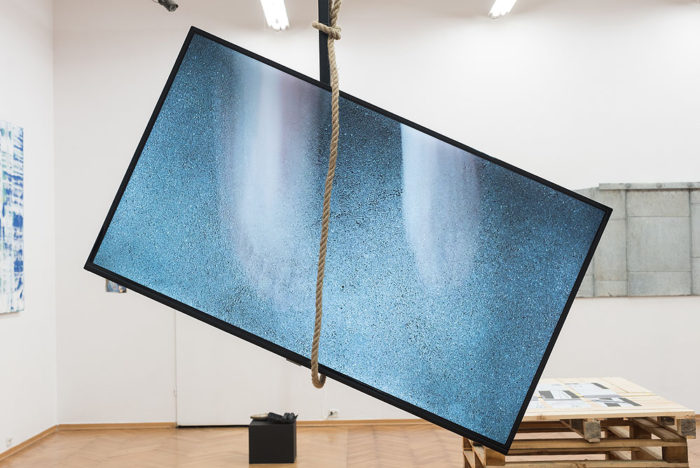Helena Kardasz
The Horizon and the Mountain video installation; 2 screens, jute rope, 2020

The Horizon and the Mountain. I decided that it would be a memory of Zenon Polus: from the moment when I first heard about the idea for the exhibition, The Flight of Icarus, when I was invited to take part in it. A collision of motion with stasis. I thought about an assumption of perspective with the point of view of a camera lens, as if 'from flight' – from above. However, an essential element here is a repetition of the image in vertical reflection, upside down. Such a situation, via a suspension of two screens combined back to back in space, offers a possibility of walking around the form, reinforcing a sensation of unboundedness of motion recorded from the viewer's perspective. A repetitiveness of a gesture, when we observe feet in collision with a raw surface of the floor, draws attention to the processuality of the action. I think that a powerful stimulus for the emergence of the idea for The Horizon and the Mountain was a recollection of pieces I produced at the Drawing Studio led by Zenon Polus, during my studies. My creative exploration of the period focused on simplified drawing gestures and symbolic forms, while I often resorted to raw matters with the use of soil/mud, stones, and cement. In particular, I remembered my large-format drawings made with jute rope and paint, as well as individual actions beyond the walls of the Institute, in spaces of a building on Ogrodowa st. in Zielona Góra under renovation, where a dominant motif in display of works was my conscious choice of screed floor. Hence my current conviction as to the idea of the flatly conceived space of the frame in The Horizon and the Mountain, which forms a fragment of the space of raw cement floor. In hindsight, my current predilection for an incisive analysis of my own practices, my tendency for undertaking varied interpretative attempts through process, my conceptual approach to the matter of art are undoubtedly a singular resultant, largely, of my presence in Polus' Studio. The symbolism of collision of moving feet with the static quality of the screed surface in the video image alludes, therefore, to personal memories, but it also constitutes a reflection on the condition of human nature, its inner, hidden and eternal desires for 'taking off the ground'. By definition, the horizon marks a limit between a space visible to observation and that occluded by the Earth. In the case of my installation The Horizon and the Mountain, for a brief moment of 'taking off', when feet 'disappear' from video image, it seems that the act of 'being above' takes place precisely beyond the frame, while symbolically, it is a transposition of the jumping persons' viewing limit. The dynamics of represented situation is reinforced by installing the screens at a 25 degree angle, which is a conventional allusion to an incline, a natural curvature of the mountain, being a reflection on 'the truth of the horizon': attempts at transcending limits in art. An added element of the piece is a jute rope, providing the context of 'suspension' in space. At the same time, it underscores a simulated character of the situation staged in front of the camera lens, as it semantically relates to the alternation of motion and stasis in video images.